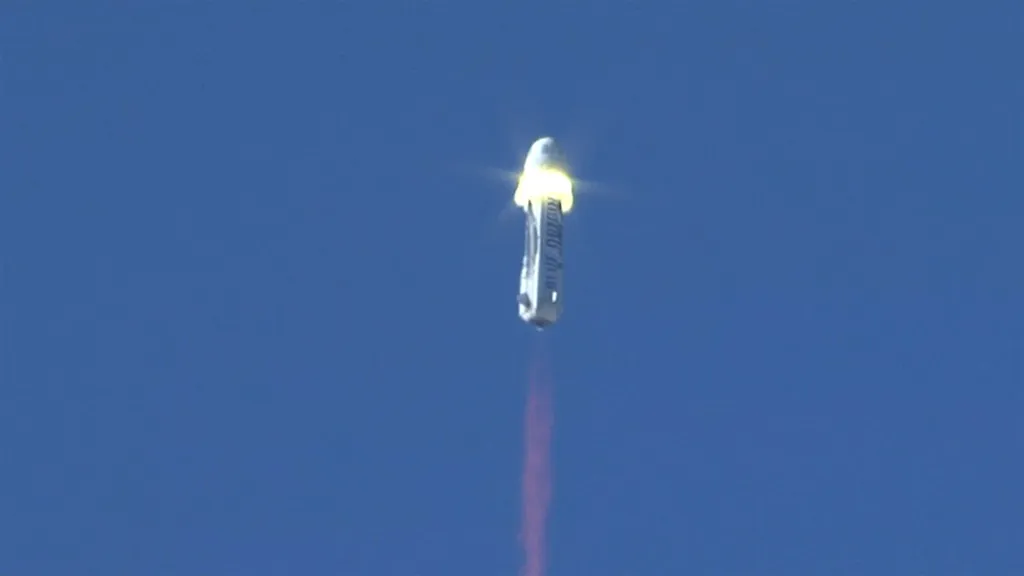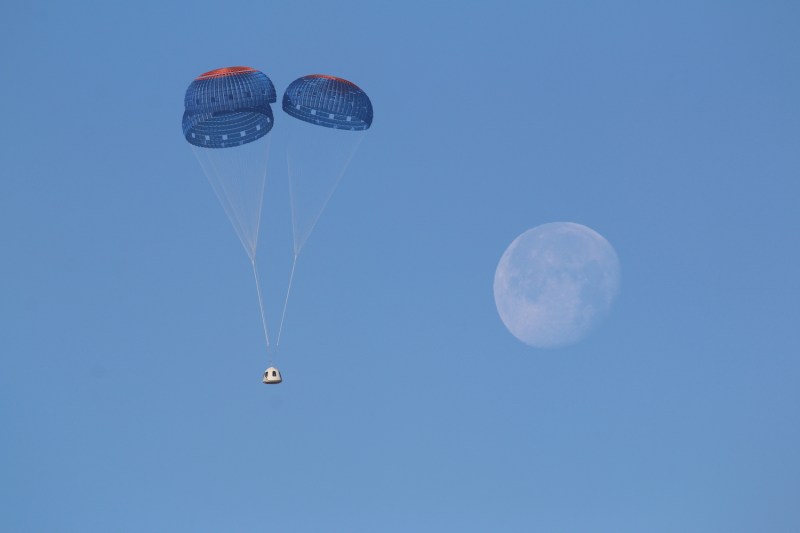Featured Image Credit: Blue Origin
Lift Off Time | September 12, 2022 – 14:01 UTC | 09:01 CDT |
|---|---|
Mission Name | NS-23 |
Launch Provider | Blue Origin |
Customer | NASA, several universities and schools, Blue Origin |
Rocket | New Shepard 3 |
Launch Location | Launch Site One, Corn Ranch, Texas, USA |
Payload mass | N/A |
Where is the spacecraft going? | Sub-orbital trajectory |
Will they be attempting to recover the first stage? | Yes |
Where will the first stage land? | It will land at Blue Origin’s landing pad, ~3.3 km (~2 miles) from the launch site. |
Will they be attempting to recover the fairings? | There are no fairings on the New Shepard vehicle. |
Are these fairings new? | There are no fairings on the New Shepard vehicle. |
This will be the: | – 4th flight for Blue Origin in 2022 – 23rd overall flight of New Shepard – 9th launch and landing of the NS3 booster |
Where to watch | Official livestream |
What’s All This Mean?
While Blue Origin has shifted to providing a 10 minute spaceflight experience for many, the company still supports scientific projects for government organizations and universities. Most of these projects include experiments that must be subjected to a microgravity environment. These flights are more appropriate for certain payloads that do not require being subjected to the vacuum of space.
Blue Origin will launch their regular booster-crew capsule configuration, but replace the humans with payloads. This booster (New Shepard Tail 3) is not human rated and flies exclusively non-human payloads.
What’s On NS-23?
Small payloads from universities, private laboratories, and government organizations will be flown inside the New Shepard crew capsule on board NS-23. The payloads total 36, 24 of which are from K-12 schools, universities and private organizations focused on Science, Technology, Engineering, and Mathematics (STEM).
Infinity Fuel Cell: AMPES
In collaboration with NASA’s Johnson Space Center, Infinity Fuel Cell will be experimenting with hydrogen fuel cell technology. This technology could be used on lunar rovers and other surface equipment such as power tools and habitats. Hydrogen fuel cells have the ability to scale, resize, and adapt to fit into nearly any hardware necessary and provide sufficient power. The purpose of this flight will be to prove the technology’s capability in microgravity.
University Of Florida: BISS
The Biological Imaging in Support of Suborbital Science (BISS) experiment has been adapt for suborbital spaceflight after originally being designed to fly aboard the International Space Station (ISS). It’s main goal is to test biological responses to suborbital missions using the FLEX florescent imaging system.
Honeybee Robotics: ASSET-1
The main goal of ASSET-1 is to test how regolith, the soil found on other planets, respond to different gravity conditions. This first flight will aim to test to the soil strength of asteroids in microgravity. Data from this experiment could help asteroid mining and drilling observations in the future. The experiment was developed by Honeybee Robotics and funded by NASA’s Flight Opportunities program.
NeoCity Academy: WoS (Wings of Steel)
A unique payload due to it’s creator, a group of six high school students. These students are from NeoCity Academy in Kissimmee, Florida, USA. Their experiment is designed to last three minutes and test the effects of microgravity on ultrasonic sound waves.
MIT Media Lab: WAX CASTING
The Wax Casting experiment is focused on the advancement of propellants such a paraffin and beeswax. Many solid propellants are hazardous and harmful to people and the environment. Wax provides a cleaner, non-toxic, and more affordable solution. On NS-23 MIT Media Lab will rotate melted candle wax and a similar liquid called heptadecane to study how the process to form fuel cells out of wax works in microgravity.
Other payloads
The list of advancing payloads continues as it reaches a total of 36. Other notable payloads include OlympiaSpace: ENGARTBOX, NASA Armstrong Flight Research Center: CFOSS, Johns Hopkins University Applied Physics Laboratory: JANUS-APL, Titan Space Technologies: T-2 Mission Arroway, and Creare, LLC and Dartmouth College: VARD.
What Is The Crew Capsule?
The New Shepard Crew Capsule has the capability to carry up to six people in a large pressurized 15 m3 (530 ft3) interior. Blue Origin’s main goal is to open up the experience of microgravity and the view of the curvature of the Earth to the general public. Each large window can let through 92% of visible light despite its structural ability to hold pressure making the experience that much more clear.
Audiences had the ability to see unique views of the people inside the capsule during the first human flight of New Shepard NS-16. This is due to the power of 12 interior cameras with HDR capabilities so great that both the interior and exterior of the capsule can be properly exposed. Future ordinary space tourists will be able to get their own personal copy of a memorable flight.

For safety, the capsule has a built-in solid-fueled abort motor known as the Crew Capsule Escape Solid Rocket Motor (CCE-SRM) in the “pusher” configuration. Check out the Everyday Astronaut video and article on the differences and advantages/disadvantages to puller versus pusher configured motors. This motor comes from Aerojet Rocketdyne and was proof tested on the final flight of NS2.
What Is New Shepard?
Aptly named New Shepard, after the first American to be launched on a suborbital trajectory, Alan Shepard, this rocket is designed for suborbital flights. So far there have been four New Shepard rockets built: NS1, NS2, NS3, and NS4. NS1 flew for the first time on April 29, 2015 and reached an altitude of 93.5 km (58.1 mi) before failing to land because of a hydraulic pressure issue. The capsule landed successfully by parachute and was recovered.

The New Shepard booster is powered by a single BE-3PM liquid-fueled engine with the capability of producing 489 kN (110,000 lbf) of thrust. The BE-3 is fueled by liquid hydrogen (LH2) and liquid oxygen (LOx) and was developed and tested by Blue Origin in the 2000s.
NS2
After the failure of NS1, Blue Origin then moved on to NS2 which completed the first successful launch and landing of a New Shepard booster on November 23, 2015 after reaching an apex of 100.5 km (62.4 miles). This marked the first time that a New Shepard rocket had carried a capsule above the Kármán line, descended it in a controlled fashion, and landed successfully on deployable landing legs. About a month later SpaceX did one better – they landed an orbital class rocket booster for the first time.
NS2 was also the booster to perform the famous in-flight abort where the Crew Capsule 2.0 fired its single solid-propellant abort motor at an altitude of 7.1 km (4.4 miles) to simulate a failure of the booster. This test was successful and both the capsule and booster were recovered. NS2 went on to complete five more successful test flights before it was retired.

NS3 for NS-23
NS-23 will be the ninth flight of the NS3 rocket. After the retirement of NS2, Blue Origin moved on to testing the still active NS3 vehicle. So far, NS3 has completed 8 successful flights with the first occurring on December 12, 2017. NS3 also flew Crew Capsule 2.0, the second iteration of the capsule. Improvements to NS3 included enhanced recovery hardware to increase reusability, as well as increased thermal protection.
NS4
NS4 has some improved accessibility panels for easier cleaning and checkouts of the hardware. NS4 has already performed five flights, in which it landed successfully along with the capsule. These tests have given Blue Origin and the FAA confidence to fly humans on this booster.





